Shopping for thermal binoculars or bioculars?
You’ve come to the right place.
Thermal binoculars and bioculars provide improved vision in low-light environments and through obstructions such a smoke, fog, dust, or bush.
Thermal binoculars typically cost more than thermal scopes and monoculars, but they offer better optical performance and are more comfortable.
Thermal binoculars are popular with hunters. They allow hunters to spot and track animals at night and through thickets. They are also useful for security, animal observations as well as search and rescue.
What’s in This Buying Guide?
In this 15-minute buying guide, we review and compare the best thermal binoculars and bioculars. We also explain all you need to know about these thermal optics and how to choose the right ones.
Thermal Imaging for Hunting
Hunters need to see their targets from a distance and, sometimes, in the dark or through thick brush. Naked eyes are good for close-up animal spotting in an open area, not so much at night when it’s foggy or thickly wooded.
You could get an ordinary pair of binoculars, a monocular or a rifle scope. But these are only useful when there’s plenty of light. That is, during a clear day.
Thermal optics, on the other hand, don’t depend on the presence of light. You can track a wild boar when it’s foggy, through a bush or even in total darkness.
The best thermal imager depends on your needs and budget.
Here’s a quick explanation of the most common types of thermal imagers.- Thermal binoculars: These look like normal binoculars but use a thermal sensor to collect infrared light from the environment. The environment appears as blobs of different colors representing varying temperatures. An anima will stand out since it gives out more heat than the environment.
- Thermal bioculars: Bioculars have one objective lens (the part that collects infrared light) like a monocular but two eyepieces like binoculars. Bioculars are slightly cheaper and lighter than binoculars. In terms of optical performance, binoculars are better.
- Thermal monoculars: A monocular has one eyepiece and one objective lens. You use it with one eye. Though they are not as good as binoculars or bioculars when it comes to optical performance, most hunters prefer thermal monoculars because they are affordable, compact, and light.
- Thermal scopes: A thermal scope is a monocular designed to be mounted on a hunting rifle. Many thermal scopes come with added built-in features to help hunters track and target prey. These include rangefinder and adjustable reticles.
Thermal Imaging vs. Night Vision?
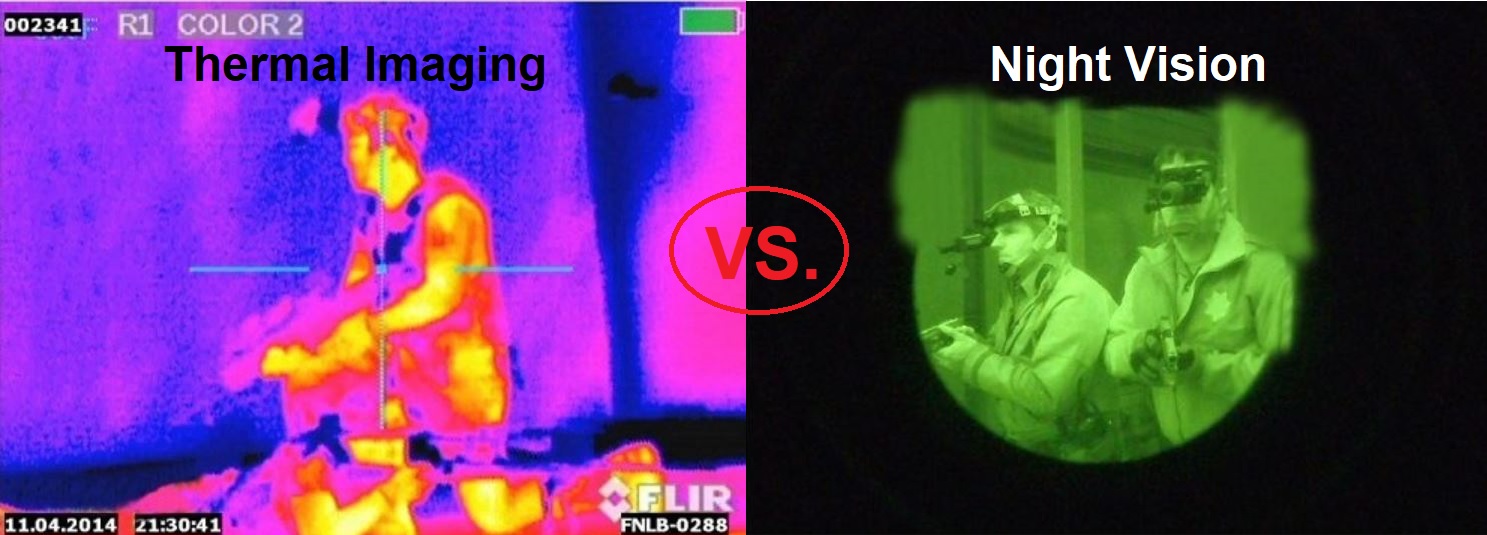
Many people mix up thermal imaging and night vision. These are two different technologies.
Thermal imaging tools and devices collect infrared radiation and turn it into a thermogram. A thermogram is an image consisting of temperature patterns, with varying heat levels represented by different colors.
Thermal imaging doesn’t rely on visible light. You can use thermal imaging to see in complete darkness or through fog, dust, rain, or smoke.
Read our quick guide to learn more about how thermal imaging cameras work.
Night vision, on the other hand, relies primarily on visible light. They collect ambient light (moonlight or starlight) and amplify it to help you see objects in the dark.
Night vision scopes and binoculars can also work if there’s no ambient light (e.g., on a moonless cloudy night) as long as they have an IR illuminator. In that case, they produce infrared light that allows them to ‘see’ in the dark.
Night vision binoculars are usually much cheaper compared to thermal binoculars. On the downside, you cannot use night vision during the day, as it may damage them. Night vision binoculars and scopes cannot see animals through bushes, smoke, fog, or rain.
If you prefer night vision, take a look at our reviews of the best cheap night vision goggles.
The 5 Best Thermal Binoculars and Bioculars Reviewed
Pulsar Accolade XP50
Best for long distance hunting
Detection range:
2,000 yards
Video Recording:
yes (+ streaming)
ATN BINOX 4T 384
Longest battery life
Detection range:
1,000 yards
Video Recording:
yes (+ streaming)
AGM Global Vision FoxBat 5 NL2 Bi-Ocular
Best for Long Viewing Sessions
Detection range:
10 m to infinity
Pulsar Accolade 2
Best Image Quality
Detection range:
2000 yards
ATN BINOX 4T 384
Best for Recording Videos
Detection range:
1800 yards
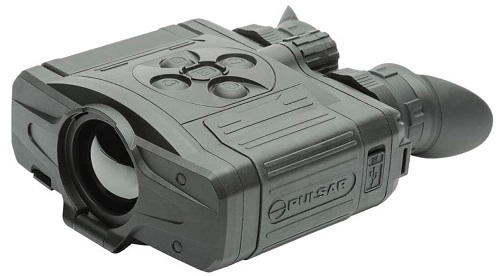
The Accolade XP50’s long detection range and powerful magnification make it a good choice for hunters who want to track targets from afar.
Pros
- Long detection range.
- Powerful magnification.
- High refresh rate.
- Includes video recording & streaming.
- Lightweight.
Our Review
The Pulsar Accolade XP50 is designed to provide long-range spotting and tracking. The binoculars can pick up the heat signature of a human-sized target from as far as 2,000 yards.
For a closer view, you can zoom in up to 20x.
The XP50 manages to retain a fairly sharp image quality for most of the zoom levels. This is thanks to the high-resolution 640x480 thermal sensor.
Pulsar’s exclusive Image Boost Technology also increases image clarity. Image Boost uses a software algorithm to increase image sharpness and overall quality.
The video recording option is perfect if you’d like to review your adventures later or share them with friends. You can record up to 150 minutes of 640x480 video or take 10,000 images. Media is stored in the internal memory (8GB), and you can download it to a computer through the USB port.
You can also stream live video to a smartphone thanks to the built-in WiFi connectivity. This is handy if you want your hunting partner to also see what you are seeing. You can also live stream directly to YouTube.
Common praise from users of the Accolade XP50 binoculars is how comfortable they are to use. They are light and, thanks to the variable interpupillary distance, you can adjust them for a perfect fit.
Another thing users love about the Accolade XP50 is their hardy construction. These binoculars have an IPX7 weather rating, meaning they are waterproof and dustproof. So don’t be afraid to take them outdoors in any kind of weather.
Battery life is not too bad. The rechargeable battery lasts around 8 hours with continuous use.
Other notable features include built-in stadiametric rangefinder, crisp AMOLED display, and picture-in-picture mode when zooming.
Issues & Limitations
The biggest limitation of the Accolade XP50 binoculars is the price. These binoculars will cost you a lot more than a scope or monocular with comparable optical performance.
Another issue is the learning curve involved. The XP50 binoculars come with so many features that it takes some time to locate all of them and find out what they do.
Bottom Line
The Pulsar Accolade XP50 binoculars are well worth the high price tag. They are great for hunters looking for weatherproof binoculars that can spot prey from a long distance.
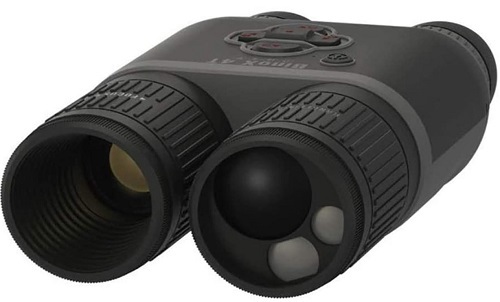
If you often go on long hunting trips, the ATN BINOX 4T binoculars are the best choice. With over 15 hours of battery life, you can enjoy days of hunting before you need to recharge.
Pros
- Extra-long battery life.
- High refresh rate.
- Video recording and streaming.
- Built-in laser rangefinder.
- Affordable.
Cons
- Smaller detection range compared to higher-resolution binoculars.
Our Review
The ATN BINOX 4T series has two sensor variations: a high-res 640x480 sensor and a 384x288 sensor. Both have the same extra-long 15-hour battery life.
In this mini-review, we’ll focus on the cheaper lower-resolution sensor. If you want better resolution and a longer detection range, see further below for our review of the ATN BINOX 4T 640.
ATN BINOX 4T 384 binoculars have a detection range of about 1,000 yards. That’s far enough for most hunters.
If you need a closer look, you can zoom in between 2x and 8x, though image quality degrades significantly as you zoom closer.
For better shot accuracy, the ATN BINOX 4T binoculars come with a built-in laser rangefinder. This is more accurate and easier to use compared to the older stadiametric rangefinder.
Another big feature of the ATN BINOX 4T 384 is dual-stream video. You can stream live video on a smartphone or tablet while also recording it onto the SD card inside the binoculars.
And unlike the Pulsar XP50, the ATN BINOX 4T records and streams HD video (1280x960 at 60fps).
ATN says the BINOX 4T binoculars are weather resistant but doesn’t provide an exact IP rating. While they are obviously okay for outdoor use, we’d be careful exposing them to extreme elements.
Issues & Limitations
The lower resolution sensor significantly lowers the price of the BINOX 4T 384 binoculars. On the downside, you get reduced detection range, lower magnification, and image distortion when you zoom.
The BINOX 4T 384 also has the same learning curve disadvantage as the Pulsar XQ50. All the features and extras included are great, but it means spending more time fiddling around with the binoculars until you know your way around it.
Bottom Line
The ATN BINOX 4T 384 is great for hunters who often spend days on hunting trips. Even without an external power pack, the internal battery in the BINOX 4T will last quite a while.
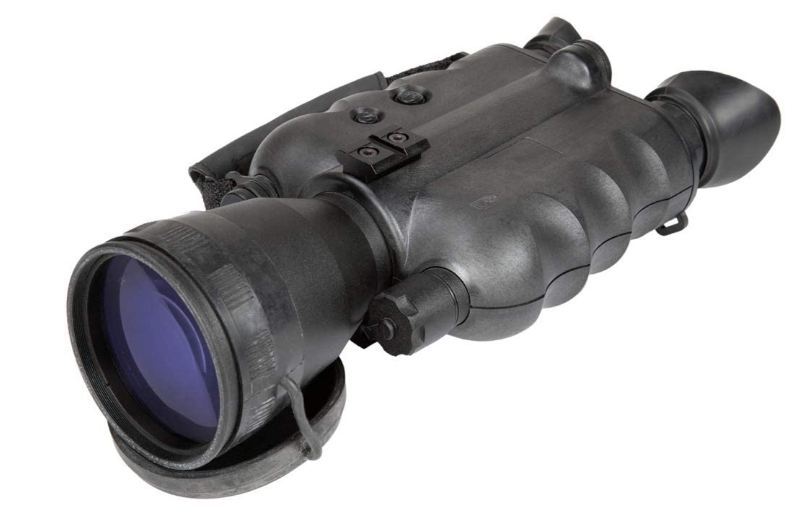
The AGM FoxBat 5 combines excellent optics and comfort to allow you to enjoy long viewing sessions in varying light conditions.
It features a detachable long-range IR illuminator and has a focus range of 10m to infinity.
Pros
- Multi-coated glass optics.
- Rugged and versatile design.
- Fog and water-resistant.
- Features a dual eye viewing system for long viewing sessions.
Cons
- No video recording or live streaming.
Our Review
The AGM Global Vision FoxBat 5 NL2 Gen 2+Level 2 biocular has a single high-quality image intensifier tube and a sturdy construction.
It is designed to be rugged with fog and water resistance to handle the rough conditions of the field.
The FoxBat 5 is perfect to use for tactical & military tasks and can be conveniently mounted on a tripod.
These bioculars have multi-coated all-glass optics that ensure optimum light transmission and top-notch image quality.
The FoxBat 5 has a 5x magnification range for convenient long-range observation. It offers adjustable brightness settings and bright light cut-off to get the best visuals of the target in varying lighting conditions.
It has digital controls and a proximity sensor for automatically shutting off the device depending on the lighting condition.
In addition, this AGM biocular features a hand strap and a neck strap to comfortably carry and use it without experiencing fatigue in the long run.
It is backed by a limited 2-year warranty.
Issues and Limitations
If you are looking for thermal binoculars that let you to live-stream images or record them, the FoxBat 5 isn’t for you. It doesn’t save images either.
Bottom Line
The AGM Global Vision FoxBat 5 has excellent optics and a dual-eye viewing system, making it perfect for mid-range and long-range viewing sessions.
Plus, its rugged and sturdy design allows it to withstand even the harshest weather conditions.
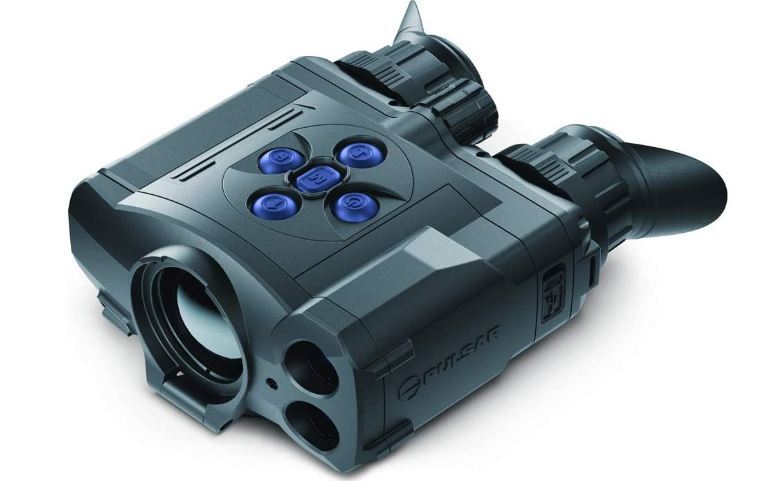
If you want a binocular that provides the best image quality along with some other premium features, the Pulsar Accolade 2 Thermal Binocular is an excellent option.
Pros
- 4x digital zoom.
- 2000-yard detection range.
- Fully IPX7 waterproof.
- Up to 8 hours of continuous operation.
Cons
- Expensive.
- No owner’s manual in the package (digital only).
Our Review
The Pulsar Accolade 2 combines superior construction with premium features and excellent image quality.
It has a sturdy and rugged aluminum construction with an IPX7 waterproof rating. It is also dustproof and fog-proof.
The Accolade 2 is equipped with high-quality thermal imaging sensors with a resolution of 640x480 and 384x288. It offers 8 color viewing palettes to choose from.
Its 17 µm pixel pitch and 50 frames per second refresh rate produce highly detailed and clear motion images.
Uniquely, the Accolade 2 has a frost-resistant AMOLED display.
This Pulsar binocular come with a built-in video recorder and Wi-Fi module that let you to record the images you’re visualizing to view them later or live-stream them through your smartphone.
The Accolade 2 has an extra-long heat detection range of up to 2,000 yards. Plus, it has a quick-charge battery that supports up to 8 hours of continuous operation.
Issues and Limitations
The Pulsar Accolade 2 is pricey because of its premium features and is unsuitable for those on a budget.
Plus, it doesn’t come with a manual; you have to download it from the website.
Bottom Line
The Pulsar Accolade 2 has a wide range of professional and semi-professional applications like hunting, scouting to LE, and life rescue.
Its feature-rich design with the high-quality image output makes it an excellent investment.
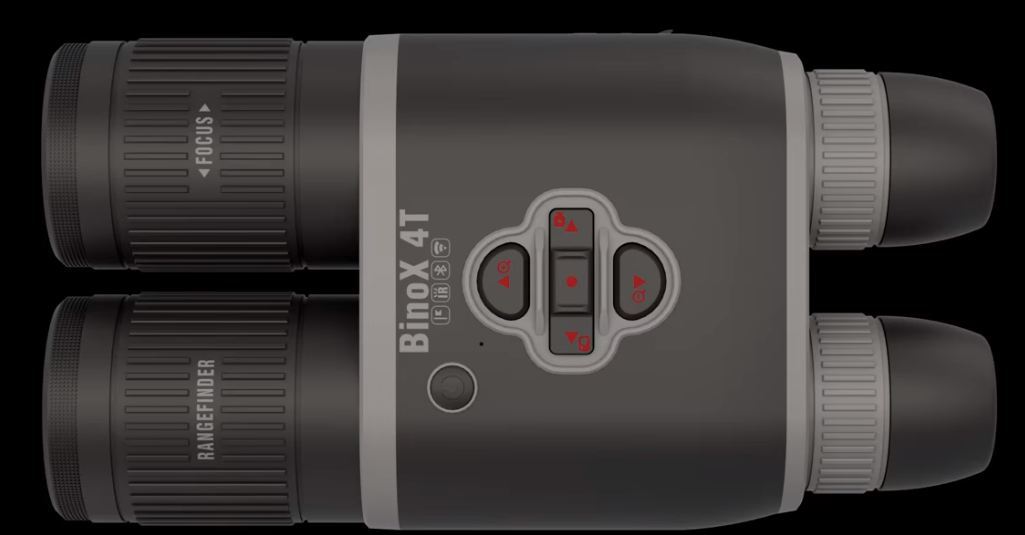
The ATN BINOX 4T 384 is one of the best thermal binoculars on the market for those who seek adventure and love to capture them - like mountaineers, hunters, etc.
Its compact design combined with a powerful battery life of up to 16 hours makes it the perfect set of video binoculars to take on a long journey.
Pros
- Comfortable eye relief.
- 16 hours of continuous battery life.
- 4.5-18x magnification range.
- Simultaneously record and live stream video.
Cons
- Not the best option for long-range viewing.
Our Review
The ATN BINOX 4T 384 has sturdy construction with a stylish black matte and gray finish.
The built-in laser rangefinder allows you to find your target with accuracy so that you know how far you need to travel to get to your next waypoint.
A major advantage of the ATN BINOX 4T 384 binoculars is its comfortable viewing experience. It doesn’t fatigue or strain the eyes, even with prolonged usage. Plus, it has an interpupillary adjustment range of 60-70 mm.
This set of binoculars has a video resolution of 1280x960 with a 60 fps refresh rate. It is weather-resistant and equipped with an internal lithium-ion battery. This new and improved battery provides 16+ hours of continuous battery life.
The BINOX 4T 384 has a human detection range of 1800 yards, a recognition range of 720 yards, and an identification range of 430 yards.
It comes with additional accessories like a carry case, USB cable, lens cover, neck strap, and a lens cleaning cloth. Plus, it is backed by a limited 3-year warranty.
Issues and Limitations
The BINOX 4T 384 is another pricy option, given its advanced features.
It is also not the best for long-range hunting because it has a human detection range of 1800 yards.
Bottom Line
The ATN BINOX 4T 384 has a sturdy and solid video binocular that can withstand tough climatic conditions you may face on the field or in the mountains.
It offers clear and crisp visuals and includes simultaneous recording and live streaming capability, unique for a set of binocs.
Thermal Binocular (and Bi-Ocular) Buying Guide
Thermal binoculars have become a staple in the hunter/adventurer’s kit.
With the advent of less expensive night vision technology and advanced features in thermal imaging, you just may have to rethink what binoculars are for.
To get the best thermal binocular for your needs, consider the following features and issues when shopping:
What is a Thermal Binocular/ Bi-Ocular, and how does it differ from a Thermal Monocular/Scope?
Thermal Binoculars/Bi-oculars are sighting tools that detect heat (infrared) signatures emitted by objects.
They serve several purposes from making the hunter aware of the target’s location and its state, to location scouting, security, etc., and are particularly useful in low-lighting situations.
When looking for thermal imaging devices, you’ll come across terms such as binocular, bi-ocular, or monocular, and distinguishing between them can be confusing.
Tools that involve looking through both of your eyes are binoculars and bi-oculars.
Binoculars have two objective lenses that collect information, while bi-oculars only have one objective lens.
Meanwhile, as the name suggests, thermal monoculars & scopes only have one lens and allow you to view the image through one eye.
How to Choose the Best Thermal Binocular/Biocular
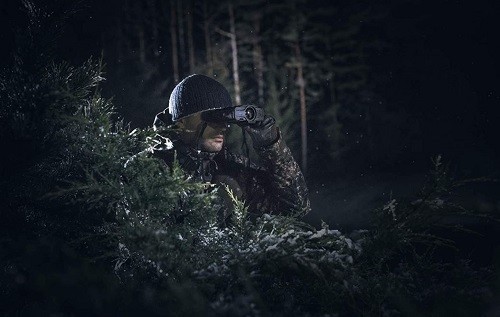
Determine the Right Resolution
The most important aspect of thermal binoculars and bioculars is thermal resolution. It tells you the quality of thermal imaging you can expect.
If you are on a budget, look for binoculars with a resolution of 384x288 or thereabouts. Images won’t be as crisp and detailed, but you’ll still see targets clearly at short to mid ranges.
One downside of a lower resolution is that you’ll rapidly lose image sharpness as you zoom. If you are buying lower-resolution binoculars, a magnification of up to 10x-15x is plenty; don’t pay for more zoom as it’ll prove useless outdoors.
If you don’t mind spending more, get a 640x480 pair of binoculars. You’ll be able to pick out an animal from further out and see more detail.
A high-resolution sensor also maintains good image quality as you zoom. With a 640x480 resolution, you can splurge on higher magnification.
Pick the Best Magnification
The best magnification depends on your hunting environment and needs.
If you hunt in a thickly wooded area, a 25x zoom won’t help you see through trees and bushes. Get a cheaper lower-magnification binocular instead.
But if you hunt in open areas, higher magnification will help you spot and track animals from afar.
And remember what we’ve discussed above about pairing the right resolution and magnification. A low resolution and high magnification don’t go well together.
What’s the Detection Range?
The detection range of binoculars depends a lot on the sensor resolution. Higher-resolution sensors can ‘see’ further.
640x480 sensors typically have a detection range of 2,000 yards or more. Binoculars with 384x288 resolution have a range of 700-1,500 yards.
Note that the specified detection range doesn’t mean you can identify an animal from that distance. The recognition range is usually less. But a long detection range is still useful as it tells you which direction to head.
Refresh Rate
Refresh rate refers to the number of frames the binocular captures in a second. A higher frame rate results in smoother and more fluid images, especially when moving or tracking a moving target.
A 50 Hz or 60 Hz refresh rate is the best. But if you are on a budget, a 30 Hz binocular will do though images will be a bit choppy when you are on the move or observing a moving animal.
Built-in Features
Video recording: Most binoculars let you record video and take images. Cheaper models have a video out option meaning you have to use a DVR if you want to record video.
Video streaming: Usually provided along with video recording. Video streaming is available only in binoculars with WiFi connectivity.
Rangefinder: Most binoculars come with a built-in rangefinder that calculates the distance to targets. Laser rangefinders are the best, but stadiametric rangefinders are more covert.
Weather Protection
You will be using the binoculars outdoors, so you want something that can withstand rough environments and some elements.
We recommend buying a waterproof and dustproof binocular.
Battery Life
If you go on long hunting trips, look for thermal binoculars that offer a long battery life of at least 8 hours.
Comfort
When it comes to comfort, there are two important aspects to consider.
One, the weight of the binoculars. If you think you’ll use them for extended periods, look for a lightweight model that won’t tire you out.
Two, check whether the binocular has an adjustable interpupillary distance. This is the distance between your eyes. Binoculars with adjustable interpupillary distance offer a guaranteed fit.
FAQs
Are thermal binoculars good for daytime hunting?
Yes, they are. Thermal imaging can help you see through bushes, dust, fog, rain, and smoke. Unlike night vision binoculars, thermal binoculars are perfectly safe to use during the day.
Which is better for hunting - a binocular or a monocular?
Both types of imagers have advantages and disadvantages.
Deciding which one is better ultimately depends upon how you plan to use it.
Monoculars are lightweight and compact and come with a strap that you can wear around your neck to ensure maximum comfort. They are also more affordable than binoculars.
A monocular is essentially a half binocular that displays a magnified image to one eye. This can have adverse effects. It is unsuitable for prolonged viewing as it strains the eye more than a binocular.
Your eyes will start to fatigue after watching magnified objects from only one eye. This is precisely why monoculars are considered best for quick glimpses and unsuitable for prolonged observation.
Binoculars tend to be heavier. And even though they come with a strap to wear around your neck, traveling with a binocular will eventually wear you down.
But when it comes to optic enhancement, binoculars are hard to beat. They have a bigger field of view as compared to monoculars, so they give you a better visual of the surroundings.
Binoculars are more comfortable to use for extended periods as they don't cause eye fatigue or strain. This makes them perfect for watching live events, scouting, tracking deer, etc.
Can thermal binoculars see through walls?
No, and the same applies to glass. Walls and glass provide enough insulation that heat from whatever is on the other side cannot pass through.
You’ll have the same problem when hunting. Thermal binoculars cannot see through trees or very thick bushes.
Are thermal binoculars better than night vision binoculars?
In some aspects, they are. For instance, thermal binoculars can see through fog, rain, and smoke, while night vision (NV) binoculars cannot.
Also, you can use thermal binoculars during the day while NV binoculars are restricted to nighttime use.
The main downside of thermal vision is the cost. Thermal binoculars can be more than ten times more expensive than night vision binoculars.
How far can thermal binoculars see?
It depends on the resolution of the sensor as well as the environment.
With a high-resolution sensor, you can see as far as 2,000 yards or longer, while a lower-resolution sensor may only allow you to see up to 1,000 yards.
In a wooded environment, you won’t see very far even with high-resolution binoculars.